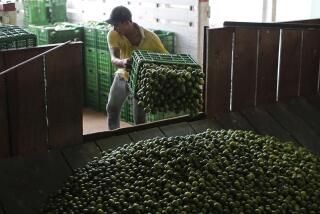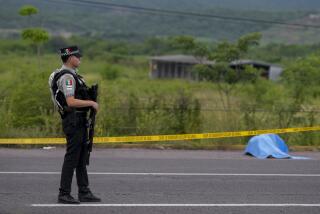U.S. Officials See Progress : Amid Protests, GIs Train Drug Fighters in Bolivia
- Share via
LA PAZ, Bolivia — Law enforcement officials are still losing the war to stop the cocaine traffic between Bolivia and the United States, but U.S. officials say that Bolivia’s special battalion of cocaine police--although widely regarded as inept and corrupt--is beginning to mend its ways.
The special battalion, known as the Leopards, has been reorganized. Since May, it has been getting jungle training from a team of U.S. Army specialists and close support from an augmented squad of Drug Enforcement Administration agents.
One optimistic U.S. official predicts that improvements in the unit’s performance could turn around the war against cocaine. “There is light at the end of the tunnel in Bolivia,” this official said the other day.
But it will take months of sterling conduct to convince some skeptics that the Leopards have changed their ways. Bolivians involved in anti-cocaine efforts say that a succession of corrupt officers has given traffickers wide latitude to operate in exchange for big bribes.
And the U.S. assistance has raised hackles here, especially among rural Bolivians who see the anti-drug effort as a threat to their only source of income.
The 14-member Army team and at least five DEA agents are based in the Chapare, a heavily forested region of central Bolivia. Peasant growers of coca leaves, the raw material for cocaine, have accused the Americans of mistreating Chapare residents.
After protests at the end of June, a federation of coca growers issued an ultimatum: If the Americans did not leave the Chapare within 48 hours, peasant masses would lay siege to the Leopards’ base at Chimore.
The Army team and five DEA agents hurried out July 2, escorted by an armed patrol of Leopards. A couple of weeks later, the Americans quietly returned, and the controversy resumed.
Representatives of four growers’ federations, which claim a combined membership of 80,000 peasant farmers in the Chapare, met July 25 and issued a new demand, that the U.S. Army team be expelled from Bolivia.
“They have to go--that is the final word of the peasant comrades,” said Rene Santander, an officer of the Special Federation of Peasants in the Tropics.
Carlos Naya, the federation’s permanent secretary, said there could be a general mobilization of all four federations against the Americans if the impasse continues. But Naya left open the possibility that the Americans could stay if the Bolivian government guarantees “certain conditions,” including respectful treatment of local residents.
Rough Treatment
Speaking at the federation office in the city of Cochabamba, Naya said U.S. soldiers or DEA agents, in the company of Leopards units, arrogantly trespass on farm plots, conduct unjustified personal searches on roadways and treat peasants roughly.
“Making babies cry, hitting all the time--that is what no one likes,” Naya said.
There also have been unconfirmed rumors of more serious abuses, such as rape. But the chief of the DEA in Bolivia said such reports and rumors are untrue.
“The traffickers have started a disinformation campaign and have persuaded peasant leaders to spread false information,” he said.
Peasant leaders deny that they are in league with cocaine traffickers. But without the traffickers, the Chapare’s huge coca production would not reach a market.
Legal consumption of coca leaves, which are chewed by Indians as a stimulant, accounts for no more than 20% of the country’s total production.
A 1986 report by a special committee of the Bolivian Senate estimated that of 260,000 acres planted with coca bushes in Bolivia, 190,000 are in the Chapare. According to the report, Bolivia’s 1985 coca crop produced more than 500 metric tons of cocaine powder, with a return for Bolivians of about $1 billion.
The Leopards battalion was created under a 1983 agreement with the United States. U.S. troops provided its initial training, and U.S. funds pay its operating costs.
In the Chapare, where most of the Leopards operate, many of their officers quickly became accustomed to being bribed for looking the other way when cocaine business was being done. Corrupt officers have been transferred to other police assignments, and a few have been dismissed, but none is known to have been prosecuted.
About three months ago, the Leopards’ command system was reorganized, putting all operations under the direct control of the general staff at Chimore. Previously, three zone commanders had nearly free rein for controlling operations in their own areas.
A U.S. official, who spoke on condition that he not be further identified, said the new command system gives fewer opportunities for traffickers to buy protection from Leopards’ officers. “Unnecessary layers of officers” have been removed, he said, and an increased DEA presence at the command center also helps limit corruption.
But asked if he believes that corruption in the Leopards is under control, the official replied: “No. I’m saying it is being addressed.”
Lt. Col. Celso Hernani was relieved in July as the Leopards’ top commander after about three months in the post. Sources said the reason for Hernani’s transfer was corruption, as it was for many of his predecessors. Hernani was replaced by Col. Armando Sandagorda, who has a solid reputation for honesty.
Meanwhile, the U.S. Army team is training Leopards in weapons use, small-unit tactics, jungle survival, land navigation, physical fitness, field medicine and sanitation. Most Leopards are highlanders with little skill in jungle operations.
Two units of about 80 men have completed the five weeks of training, and a third unit has begun the course. All 500 Leopards are to be given the course over a period of several months.
The American official said the training has been “extremely effective” in the units that have received it.
The Leopards are also receiving training from DEA agents in drug control and search techniques. As a result of new training and reforms, the U.S. official said, “we have seen a sharp increase in their successes in the last two months.”
One problem the Leopards did have in that period, however, was the grounding for seven weeks of six UH-1H Huey helicopters on loan from the United States. Flight insurance for Bolivia’s air force had expired while the government was wrangling with the insurance company over claims.
With help from the U.S. government, a separate insurance policy was arranged for the Hueys, and the choppers began flying anti-cocaine missions again July 24. The American official said that improved performance by Leopard ground forces in coca-growing areas of the Chapare will free the helicopters for more operations against cocaine laboratories in the adjacent provinces of Beni and Santa Cruz.
Despite American optimism, however, a Bolivian expert on coca matters in the Chapare said there is no sign so far of increased repression. He said the price for coca leaves in some parts of the Chapare has risen since early June to as much as $115 per 100-pound bundle.
The expert said that if the repression of traffickers were effective, fewer would be buying the leaves and the price would drop.
Most experts agree that the way to resolve the problem is to disrupt cocaine trafficking and force down the price of leaves. If the price can be kept below $40 per 100 pounds, which is the average cost of production, most farmers will stop cultivating coca, the experts say.
Last year, when 160 U.S. soldiers and Black Hawk helicopters were in Bolivia for anti-cocaine operations with the Leopards, the price of coca leaves fell to as little as $10 per 100 pounds.
The Bolivian expert said that high prices in the Chapare invariably mean that traffickers are receiving police protection.
But according to the government of President Victor Paz Estenssoro, there is no protection. “I emphatically declare that no protection exists for narcotics traffic,” Interior Minister Juan Carlos Duran told reporters in late July.
Fernando Barthelemy, Duran’s predecessor as interior minister, was the most prominent suspect in an investigation completed in July by a special committee of the Chamber of Deputies, the lower house of the Bolivian Congress. The committee, which includes a member of the government party, has called for indictments against Barthelemy and eight others in a drug bribery case involving the Leopards.
Debate on the committee’s report is expected to start as soon as the chamber gets organized following a recess. The chamber, which was convened Monday, will also consider a comprehensive anti-narcotics bill that has already been approved by the Senate.
The proposed law would allow 12 months for Bolivian coca leaf production to be cut to 10,000 tons, all licensed and tightly controlled. After that, anyone caught planting, cultivating, harvesting or gathering unlicensed coca leaves would be subject to a prison sentence of two to eight years.
The bill, submitted by the government, is part of a three-year plan for combatting Bolivia’s cocaine trade. The plan calls for tough repression of traffickers, and for rural development projects that would give coca growers aid for producing and marketing other crops.
Government officials have estimated that the plan will cost at least $100 million a year, and that Bolivia can come up with no more than 20% of that. The U.S. government has promised a substantial contribution, but has asked Bolivia to seek help from other countries and international agencies.
In June, under pressure from coca growers, the government signed an agreement with Bolivia’s main labor federations that questions some concepts of the three-year plan. The agreement says that “without greater financial support to the government and people of Bolivia, it will not be possible to confront a problem of such magnitude.”
The agreement also emphasizes that coca crop substitution should be voluntary, with adequate compensation to peasant growers who destroy coca bushes. It says government and labor representatives will form a committee to draft changes in the three-year plan and in the anti-narcotics bill.
Bolivia and the United States signed an anti-cocaine agreement in March based on the three-year plan. Two annexes to the unpublished agreement will take effect soon, specifying U.S. aid for cocaine interdiction and for coca crop substitution.
An American official said the annex on crop substitution calls for the eradication of a relatively modest 4,500 acres of coca bushes in an initial 12-month period.
“It’s a beginning,” the official said.
More to Read
Sign up for Essential California
The most important California stories and recommendations in your inbox every morning.
You may occasionally receive promotional content from the Los Angeles Times.









